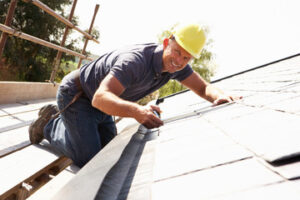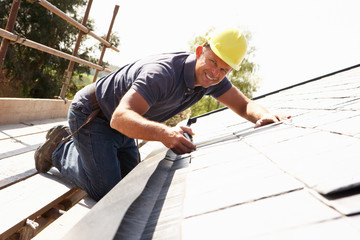Residential Roofing is used to protect the home from harsh weather elements. Several different types of roofs can be installed. Each type of roof serves a specific purpose. Many homeowners choose a metal roof because it is fire-resistant and can qualify them for a lower homeowner’s insurance premium. Metal roofs are also durable and can withstand high winds.
 The best way to avoid these issues is by hiring a professional Roofing Company Near Me specializing in residential roofs. This can help to ensure that the job is done correctly and that any warranties or guarantees are properly adhered to. Finding a roofer with whom you can build a working relationship and who will be available when you need them is also a good idea. This will give you fresh eyes on your home and the opportunity to develop a trusting relationship that may benefit both parties in the long run.
The best way to avoid these issues is by hiring a professional Roofing Company Near Me specializing in residential roofs. This can help to ensure that the job is done correctly and that any warranties or guarantees are properly adhered to. Finding a roofer with whom you can build a working relationship and who will be available when you need them is also a good idea. This will give you fresh eyes on your home and the opportunity to develop a trusting relationship that may benefit both parties in the long run.
When you are building a new home or replacing your existing roof, there are many factors to consider. The type of roof you choose affects the look and feel of your house, as well as its overall value. The roof protects your home from the elements and weather, so ensuring it suits your area’s climate is important. There are also a variety of roofing materials to choose from, each with their own pros and cons.
Asphalt shingles are the most popular residential roofing material. They are economical and easy to install. They are available in a wide range of colors and styles. They are also durable and resistant to fire, mold, rot, and pests. However, they are not as energy-efficient as other types of roofs.
Another option is metal roofing. It is a highly durable roofing material that resists heat, wind, and rain, and it comes in a wide variety of styles, including standing seam, corrugated, and flat panels. It is also available in a variety of colors, shapes, and textures. However, metal roofing is not as aesthetically pleasing as other types of roofs.
A tile or slate roof is a beautiful and classic choice for your home. They come in a variety of colors and styles, and they can be made to match any architectural style. However, they are usually more expensive than other roofing materials.
If you’re looking for a roof that is eco-friendly, try a solar shingle. These shingles contain a special solar panel that can absorb and store energy from the sun, reducing your energy bill.
Pitched or sloping roofs are ideal for areas that experience frequent rainfall or heavy snowfall. They have higher stability and offer better water runoff than flat or low-sloped roofs. They are also easier to install than a flat roof, and they can be built from a variety of materials, including shingles, wood, clay or concrete tiles, and metal.
Materials
When it comes to Roofing, there is no shortage of options available for homeowners. From traditional asphalt shingles to copper or slate, there are many different ways to enclose your home’s structure with an attractive and durable covering. The decision of which material to use will likely come down to a combination of factors, including cost, functionality and style. Using a quality roofing material can help you achieve the aesthetic you desire for your home and will add to its value should you ever decide to sell it.
The most common type of roofing material is asphalt shingles. This affordable option is durable, easy to install and can be found in a variety of styles to match the design of your house. If you are looking to upgrade your roof with something more attractive, consider investing in architectural shingles. These shingles are thicker and have an appealing granule pattern that helps them to resist the elements.
Wood shake shingles are another popular roofing material that can add to the curb appeal of your home and increase its resale value. They are made from natural materials that are environmentally friendly and are durable enough to last 30 years or more. However, the installation process can be time-consuming and labor-intensive.
Metal roofs are a great choice for homes in hot climates, as they can withstand high winds and other weather conditions that would damage most other types of roofing materials. They are also fire-resistant and can help improve your home’s energy efficiency. If you are considering a metal roof, be sure to have it properly installed by a qualified contractor.
Another good roofing option is concrete tiles, which are molded from earthen clays and fired for durability. They can be used in a variety of styles and are suitable for most climates, with some being tested to hold up against 125-mile-per-hour winds that would rip off other shingle types. However, they can be expensive and require regular maintenance. For those looking for a more sustainable option, consider installing solar shingles on your roof. These shingles produce energy for your house and can be used to offset the cost of your electricity bill.
Design
When designing a new home or replacing an existing roof, there are many considerations to keep in mind. These include the roofing material, roof structure and style, as well as the overall architectural design of the house. Choosing the right residential roof will protect your home and improve its curb appeal, while also helping to save energy costs and prevent water damage.
The most common residential roofing materials include asphalt shingles, metal, tile, and wood shakes. Each type has its own unique characteristics, benefits, and drawbacks. However, asphalt shingles are the most popular choice due to their affordability and ease of installation. Metal and tile roofs are more durable, but they can be expensive and require specialized installation. Wood shakes offer a natural look and feel, but they are more prone to leaks and need regular maintenance.
Regardless of the type of roof you choose, it is important to consider the architectural style of your house and the local climate before making a decision. A roof should be able to withstand the weather conditions in your area and comply with local building codes. The design of a residential roof should also take into account the homeowner’s priorities and lifestyle.
Another aspect of a residential roof is its ventilation system. This includes intake and exhaust vents that allow air to circulate throughout the roof, preventing moisture buildup. Proper ventilation also helps to regulate indoor temperatures and reduce the risk of mold, mildew, and ice dams.
In addition to venting systems, a residential roof can also include drip edges, valleys, and flashing. These are used to protect the edges of the roof and prevent water from seeping under the eaves. They also help to prevent the accumulation of debris on the roof and in gutters. In addition, a roof may have valleys, skylights, chimneys, and other fixtures that need to be sealed. These components should be properly sealed to prevent water from leaking into the interior of the home. The design of a residential roof should incorporate these elements to ensure its long-term performance and durability.
Maintenance
Residential Roofing is a multifaceted industry that involves the design, materials and installation of roofs specifically for homes and other small buildings. While there are many different types of roofs, asphalt shingles are one of the most popular options because they are affordable and easy to install on a variety of building styles. However, even this popular option can cause problems if it isn’t properly maintained.
In addition to the obvious issues with water leaks and other structural damage, there are other potential problems that homeowners need to be aware of when it comes to their roof. For example, if a homeowner neglects to clean their gutters, they could end up with clogs that lead to the overflow of rainwater and the eventual penetration of water into the house’s foundation. It is also important to keep an eye out for any moss or algae growth, as these can lead to discoloration and the build-up of mold or mildew on the roof itself.
When hiring a residential roofing contractor, it is a good idea to check their references and certifications before making a decision. You should also ask for proof of liability insurance and workers’ compensation. Additionally, you should inquire about the process of removing existing roofing material and whether any special treatment will be needed for the areas that are exposed. For instance, a new roof may need to be treated with zinc flashing and strips higher up on the roof, as these will leach over time and kill organisms that can otherwise lead to discoloration, moss and mildew.
